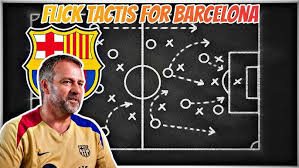Hansi Flick's Tactical Shift: The Possibility of Four Centre-Backs Against Barcelona
SPORT
5/4/20257 min read


Introduction to Hansi Flick's Tactics
Hansi Flick, the head coach of the German national team, is renowned for his tactical acumen and adaptive approach to football. His coaching philosophy is rooted in a blend of possession-based football and high pressing that seeks to exploit the weaknesses of opponents while maximizing the strengths of his own squad. Flick’s journey began at Bayern Munich, where he notably transformed the team's dynamics following his appointment in November 2019. Under his management, Bayern demonstrated a fluid attacking style characterized by quick transitions and positional interchanges.
Throughout his tenure, Flick employed various formations including the 4-2-3-1 and 4-3-3 setups, which allowed for flexibility in both defensive and offensive phases of play. The 4-2-3-1 formation, for instance, facilitated effective control in midfield, enabling intricate passing sequences and creative build-up play. Conversely, the 4-3-3 setup provided width and pace, stretching opponents and creating space for attacking opportunities. This versatility has been particularly evident in high-stakes matches where tactical adaptability is crucial for achieving favorable outcomes. His penchant for adjusting formations based on the opponent’s strengths and weaknesses has been a hallmark of his coaching strategy.
As the prospect of a shift to a four centre-back formation looms, it is essential to consider how this tactical evolution aligns with his overarching philosophy. This adjustment may serve as a strategic response designed to enhance defensive solidity while still ensuring offensive prowess. Flick’s ability to convey his tactical vision to players and implement it effectively on the pitch has yielded significant success, garnering a reputation for being one of the most astute tacticians in contemporary football.
The Context of the Match: Barcelona vs. Inter
The upcoming match between FC Barcelona and Inter Milan holds significant importance within the current season. Scheduled to be a pivotal encounter in the UEFA Champions League group stage, this fixture not only affects the immediate standings but could also have lasting implications for both teams' aspirations throughout the tournament. Historically, encounters between Barcelona and Inter have been marked by high intensity and memorable moments, adding an extra layer of anticipation for players and fans alike.
This meeting is also critical considering the previous encounters between these teams. Their most recent clash showcased a tactical chess match where both coaches implemented differentiated strategies to outwit each other. The historical context adds pressure to the players as they seek to emulate past feats or avenge prior losses. As the match approaches, analyses focus on potential strategies, including Hansi Flick's possible deployment of four centre-backs to bolster defense, potentially dictating the tactical narrative of this upcoming showdown. With all factors combined, the anticipation surrounding this match is palpable, making it a must-watch event for football enthusiasts.
Rationale Behind Using Four Centre-Backs
Hansi Flick's consideration for employing a formation featuring four centre-backs represents a significant tactical shift aimed at enhancing defensive stability. This strategic decision can be largely attributed to the growing complexity of modern attacking styles exemplified by teams like Barcelona, known for their dynamic and fluid offensive play. By fielding four centre-backs, Flick could bolster the defensive line, ensuring that his team remains resolute against a range of attacking threats.
The deployment of four centre-backs also provides a layer of adaptability. In matches against formidable opposition, such as Barcelona, having an additional centre-back facilitates a more robust defensive setup that can effectively counter various attacking formations. This pragmatic approach allows for seamless transitions between a back three and a back four, depending on the match scenario. Such flexibility can be crucial when dealing with the swift changes in tactical formations that Barcelona may employ during a high-stakes encounter.
Furthermore, this setup could offer enhanced aerial strength and physical presence in the penalty area, which is particularly advantageous against a team that utilizes height for set-pieces and crosses. The increased size in the defensive line could also deter potential threats posed by pacy wingers and versatile forwards, enabling defenders to assert dominance during key moments within matches. As a result, this tactical shift not only fortifies the back line but also promotes a cohesive unit that operates effectively under pressure.
In aligning with this strategy, Hansi Flick demonstrates a commitment to evolving his team’s tactical framework, preparing them for high-caliber challenges. This shift, while conservative, embraces a calculated approach that could yield significant dividends in terms of defensive organization and overall team performance against elite opponents such as Barcelona.
Analyzing Barcelona's Strengths and Weaknesses
FC Barcelona has long been known for its dynamic attacking style, characterized by quick passing, fluid movement, and individual brilliance. Currently, the team features several key players who embody this philosophy, such as Robert Lewandowski, Pedri, and Ansu Fati. These individuals not only contribute to Barcelona's goal-scoring capabilities but also facilitate the team's overall offense through their technical skills and ability to exploit defensive lapses.
Barcelona's strengths lie in their ability to maintain possession and create opportunities through intricate combinations in the final third. The midfield duo of Gavi and Frenkie de Jong provides a strong foundation, allowing the attackers to flourish. Moreover, the versatility of these players ensures that Barcelona can adapt to various defensive setups, making it challenging for opposing teams to mark them effectively. Their pressing style further enhances their performance, aiming to regain possession high up the pitch, which can exert constant pressure on rival defenses.
However, despite their offensive prowess, Barcelona has displayed some vulnerabilities that a tactical shift like Hansi Flick's proposed formation with four centre-backs could take advantage of. One notable weakness is their reliance on full-backs for width and support in attacks, which, if neutralized, can limit their options in the final third. Furthermore, the defensive line has sometimes struggled with pace, particularly on the counter-attack, exposing them to quick transitions from opponents.
Flick’s strategy could be beneficial in stifling Barcelona’s passing lanes and shielding against their attacking threats. By employing a robust four-centre-back formation, Bayern Munich can effectively double up on key attacking players, cutting down the available passing options for Barcelona and disrupting their rhythm. This tactical approach might encourage Barcelona to rely heavily on their wing play, a strategy that could be countered effectively with solid defensive organization.
Possible Lineups and Player Roles
In the event that Hansi Flick decides to deploy a formation with four centre-backs against Barcelona, the team's lineup could reflect a profound tactical adjustment aimed at bolstering defensive solidity while allowing for strategic transitions. This shift may be exemplified by deploying two established central defenders alongside two wing-backs, who would serve dual roles in defense and attack. For instance, players such as Matthijs de Ligt and Lucas Hernández could anchor the central positions, providing physicality and aerial strength, while the wing-backs could be filled by Joshua Kimmich and Alphonso Davies, known for their pace and attacking contributions.
The two central defenders may have the primary responsibility of marshaling the backline, coordinating defensive actions, and maintaining a compact shape against Barcelona's potent attacking threats. The wing-backs, in this system, could exploit the flanks with overlapping runs, providing width to the attack as they transition from defense to offense. This balance may enable the team to maintain defensive integrity while simultaneously offering offensive width, a vital aspect given Barcelona's tendency to dominate central spaces.
In the midfield, Flick might consider adjusting the roles of his players to complement the increased defensive presence. A double-pivot could be established, consisting of two more defensively-minded midfielders, such as Leon Goretzka and Joshua Kimmich, ensuring the team is well-covered defensively while still facilitating the distribution of the ball to the forwards. This modification of roles, combined with the anchoring presence of a central attacking midfielder, could offer creative options to improvise penetrating passes to the front line. The overall dynamics would hinge on fluidity, allowing defenders to engage in attacks while still possessing a strong defensive base, optimizing the team's chances against Barcelona's tactical prowess.
Risks and Challenges of the Formation
Utilizing a formation featuring four centre-backs presents a number of risks and challenges, particularly in high-stakes matches against formidable opponents such as Barcelona. One of the primary concerns is the potential for defensive vulnerabilities that could arise from this setup. While the intention of employing four centre-backs is to create a solid defensive line, it may inadvertently lead to a lack of mobility and flexibility in the back. This restriction could allow Barcelona's quick attackers to exploit spaces between the defenders, especially during counter-attacks.
Moreover, the challenge of transition play can be significant when utilizing a four-centre-back formation. Transitioning from defense to attack generally relies on the fluid movement of players and quick decision-making. However, with an additional centre-back on the pitch, it is essential that players adjust to maintain a cohesive unit. The extra defender may slow down the build-up play, potentially disrupting the team's rhythm, which is critical when facing a technically adept team like Barcelona. This alteration can lead to missed opportunities in front of the goal or an inability to capitalize on counter-attacking situations.
Another important aspect to consider is how this formation could impact the team’s attacking capabilities. A traditional setup that relies heavily on wing-backs for support in attack may suffer, as the presence of an additional centre-back potentially limits width and movement forward. Attacking dynamics may become predictable, making it easier for Barcelona’s disciplined defense to anticipate and neutralize threats. Therefore, thorough consideration of the trade-offs is necessary, as the implications of these strategic choices could significantly influence the outcome of the match against such a talented squad like Barcelona.
Conclusion
Hansi Flick's consideration of deploying four centre-backs against Barcelona signifies a notable tactical shift with potentially far-reaching implications for the team's approach in future matches. This strategy not only highlights Flick's inclination towards adaptability but also emphasizes a defensive solidity that could reshape Bayern Munich’s identity on the field. By embracing this unorthodox formation, Flick is potentially setting a precedent that champions tactical versatility, an essential trait in modern football.
The immediate impact of such a decision may enhance the team's defensive capabilities, allowing for a more robust approach when facing elite opponents. The ability to flexibly alter formations may also deter future opponents, who could be unsure of how to approach a Flick-led team. Moreover, this adaptation may evoke a strengthened mentality within the squad, fostering an environment conducive to innovation and strategic experimentation.
However, the longer-term implications of this tactical shift cannot be overlooked. If successful, it could lead to greater confidence among players in utilizing varied systems, empowering them to adjust to diverse styles of play. This, in turn, may foster the development of younger talents within the squad, as they learn to navigate and thrive in multiple tactical frameworks. Furthermore, if Flick continues to deploy four centre-backs regularly, it could signal a significant evolution in Bayern Munich's playing philosophy, where flexibility and defensive organization become paramount in their quest for domestic and European success.
In conclusion, Flick's tactical maneuvering represents much more than just a single game plan against Barcelona; it marks a potential transformation in Bayern Munich’s footballing narrative, encompassing both current practices and future aspirations. The ramifications of this decision could resonate throughout the season, fundamentally shaping the club's journey in a highly competitive landscape.
